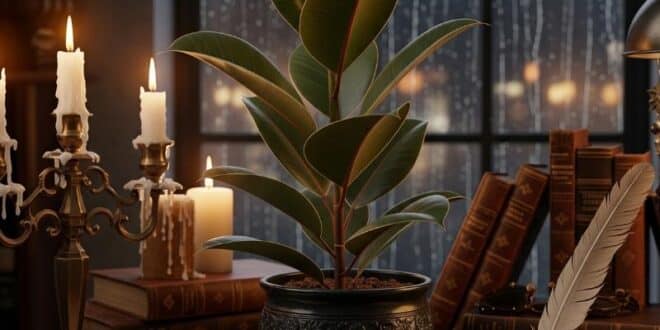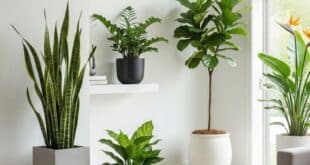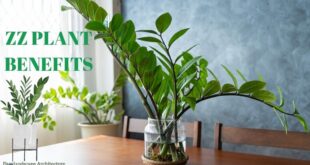Dark Academia
is more than an aesthetic; it is a scholarly romance with the past. This beautifully evocative description captures the essence of an intellectual aesthetic—a world steeped in nostalgia and depth. It’s the scent of old books mingling with the freshness of rainy afternoons, the warmth of candlelight casting shadows on dark wood furniture, and the comforting weight of a tweed jacket that speaks to timeless style. It’s a space where classic literature, art, and the pursuit of knowledge reign supreme, inviting moments of quiet reflection and immersion in the richness of narrative and history.
In this moody and intellectual sanctuary, plants are not mere decorations. Living specimens, they serve as companions in study and thought. They represent the untamed, poetic side of nature encroaching upon the ordered world of academia. As subjects for botanical illustration, they stand as silent witnesses to late-night reading sessions and a connection to the long history of science and exploration.
To curate your own scholarly greenhouse, here is a list of 18 plants that perfectly capture the moody, contemplative, and deeply romantic spirit of Dark Academia.
The Classics of the Conservatory
Fiddle Leaf Fig (Ficus lyrata) – The Grand Orator
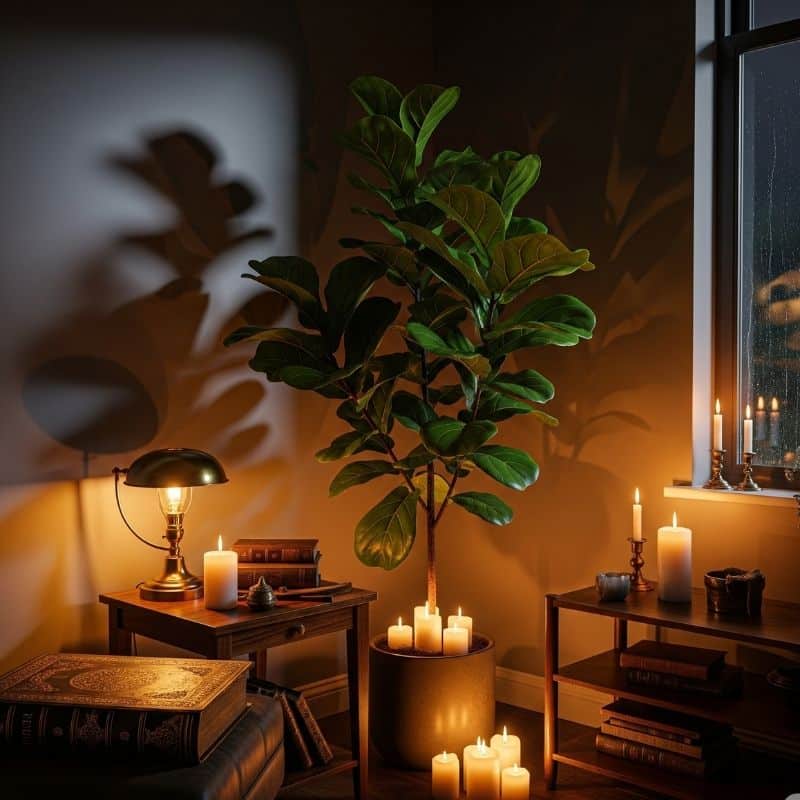
The Fiddle Leaf Fig commands a room with the presence of a seasoned professor in a lecture hall. Its large, dark green, lyre-shaped leaves are dramatic and sculptural, creating a powerful focal point that speaks of gravitas and classical form.
The Dark Academia Connection: This plant’s grand scale and architectural presence feel at home amongst tall bookshelves and high ceilings. Because it requires consistent, thoughtful care, it becomes a long-term companion in study, its growth marking the passing of academic seasons. As a result, it’s not just a plant but a living testament to dedication and patience.
- Aesthetic Contribution: Adds a bold, sculptural, and dramatic element of living architecture.
- Styling & Materials: It thrives in a large, heavy-bottomed terracotta or dark ceramic pot, standing as a solitary statement piece.
- The Scholarly Factor: Its impressive form has graced the pages of architectural and design books for decades, making it a classic subject of study in its own right.
Rubber Plant (Ficus elastica ‘Black Prince’) – The Somber Poet
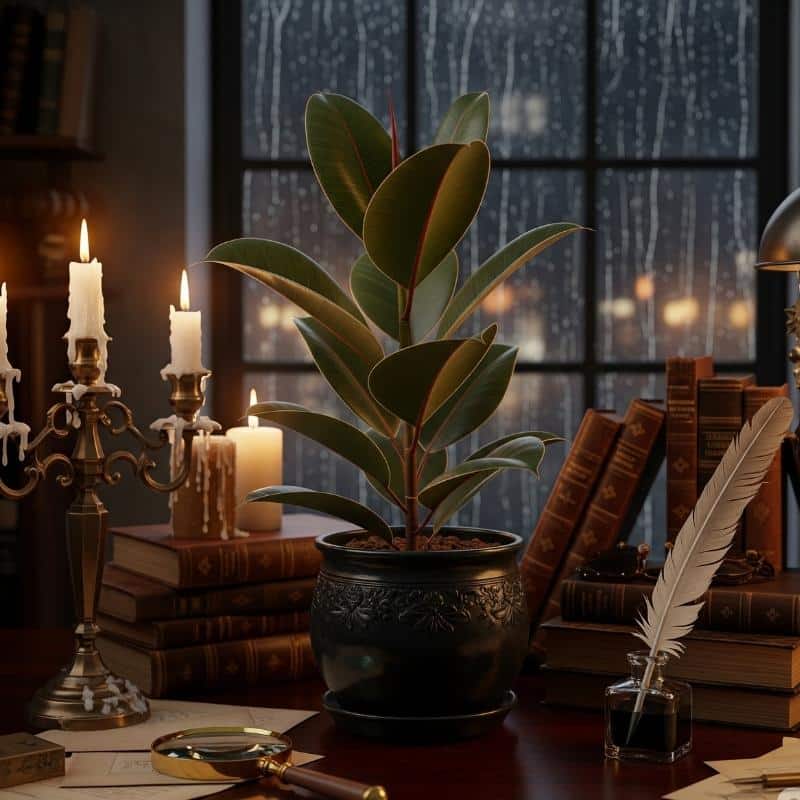
With leaves so dark they appear almost black, this variety of Rubber Plant is the epitome of moody elegance. It doesn’t scream for attention; instead, it absorbs the light, adding a quiet depth and contemplative stillness to a room.
The Dark Academia Connection: The Dark Academia aesthetic often explores themes of melancholy and introspection. Because the ‘Black Prince’ has such a dark and brooding coloration, it perfectly sets a scene for reading tragic poetry or listening to classical music. Therefore, it provides a sophisticated, dark canvas against which lighter objects—a marble bust, a stack of cream-paged books—can truly stand out.
- Aesthetic Contribution: Introduces a powerful point of dark, moody contrast.
- Styling & Materials: Looks exceptional in an aged brass or copper planter, complementing its dark leaves with a hint of metallic warmth.
- The Scholarly Factor: Its botanical name, Ficus elastica, hints at its history as a source of natural rubber, a story of science and industry.
ZZ Plant (Zamioculcas zamiifolia ‘Raven’) – The Midnight Scholar

The Raven ZZ Plant is a modern classic perfectly suited for this aesthetic. New growth emerges a bright, electric green before slowly maturing into a rich, velvety, near-black. This transformation is a slow, unfolding narrative.
The Dark Academia Connection: This plant’s life cycle mirrors the process of study itself. Because it transforms from bright green to deep black over time, it represents knowledge being slowly absorbed and deepened, moving from nascent idea to profound understanding. As a result, its presence is a quiet reminder of the value of slow, deliberate learning. Its tolerance for low light makes it the perfect companion for a dimly lit study.
- Aesthetic Contribution: Provides a dynamic color story, from bright lime to deep, matte black.
- Styling & Materials: A simple, dark grey or black ceramic pot allows its unique color and form to be the main focus.
- The Scholarly Factor: Its resilience and low-light tolerance make it the ideal plant for a busy student or writer who might occasionally forget to water it during a deep dive into research.
Coffee Plant (Coffea arabica) – The Writer’s Muse
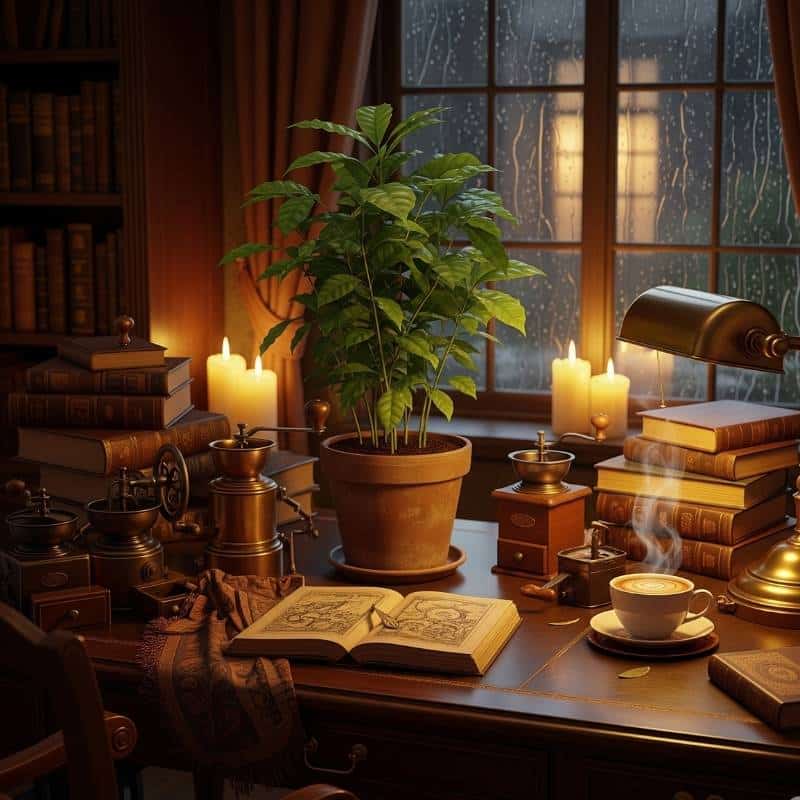
What could be more appropriate for an intellectual aesthetic than the very plant that produces the fuel for late-night study sessions? The Coffee Plant, with its glossy, dark green leaves and the eventual promise of fragrant white flowers, is a beautiful and symbolic choice.
The Dark Academia Connection: This plant is literally the source of a scholar’s ritual. Because it is the origin of coffee, the lifeblood of writers, philosophers, and academics for centuries, its presence is a direct nod to the history of intellectual pursuit. Consequently, caring for a coffee plant is like nurturing your own source of inspiration.
- Aesthetic Contribution: A lush, bushy plant with vibrant, glossy foliage.
- Styling & Materials: Looks wonderful in a classic, dark brown ceramic pot on a desk or side table.
- The Scholarly Factor: The journey from plant to bean to cup is a fascinating botanical and chemical process, making it a wonderful subject of study.
Boston Fern (Nephrolepis exaltata) – The Victorian Botanist

The lush, feathery fronds of the Boston Fern evoke the atmosphere of a 19th-century conservatory or a cluttered Victorian study, filled with natural history specimens and curiosities.
The Dark Academia Connection: The Victorian period was a golden age for botany and specimen collection, serving as a central theme in Dark Academia. Because the Boston Fern was a staple of these historic interiors, it brings an immediate sense of history and classicism to a space. As a result, it makes a room feel like a timeless haven for a naturalist or a historian.
- Aesthetic Contribution: Adds a soft, wild, and slightly chaotic texture that contrasts beautifully with ordered rows of books.
- Styling & Materials: It thrives in a hanging basket or on a tall, ornate plant stand, allowing its fronds to arch freely. An aged terracotta pot enhances its classic feel.
- The Scholarly Factor: Ferns are an ancient lineage of plants, and their study connects one to the deep history of life on Earth.
Trailing Vines & Poetic Shadows
English Ivy (Hedera helix) – The Hallowed Halls
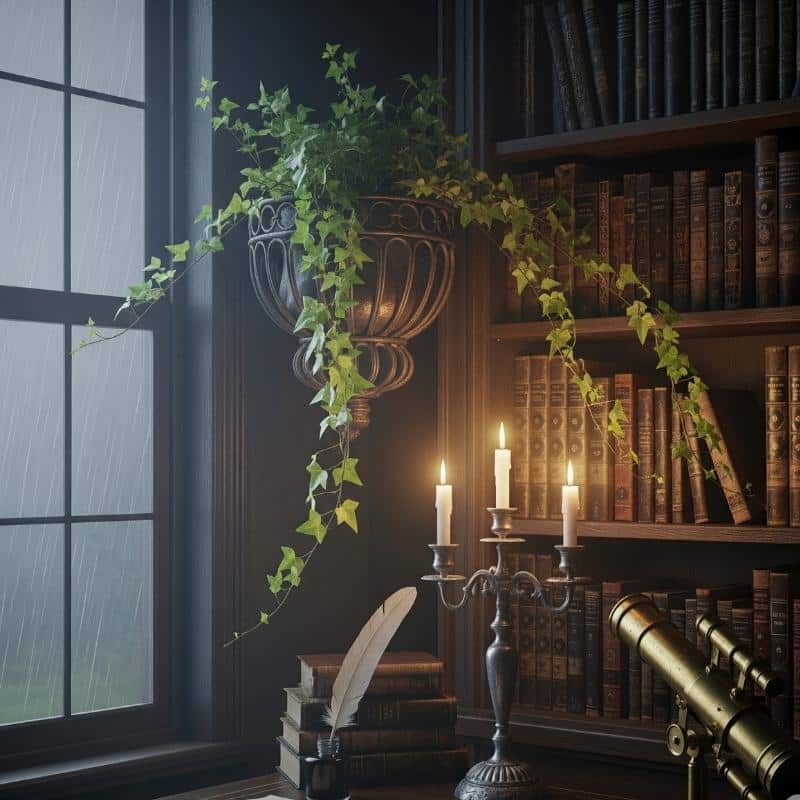
Nothing says “ancient university” quite like ivy-covered stone walls. Bringing English Ivy indoors captures a piece of that timeless, scholarly atmosphere. Its familiar lobed leaves and tenacious climbing habit are a living symbol of tradition and endurance.
The Dark Academia Connection: This plant tells a story of time and persistence. Because ivy slowly but surely covers surfaces, it represents the gradual accumulation of knowledge and the enduring legacy of an institution. Therefore, having it trail across a bookshelf or up a wall is like inviting the spirit of a centuries-old library into your own study.
- Aesthetic Contribution: Creates romantic, trailing lines and casts beautiful, soft shadows in low light.
- Styling & Materials: Let it trail from a bust of a classical figure, a pewter mug on a mantelpiece, or train it to grow around a window frame.
- The Scholarly Factor: Ivy features heavily in classical mythology and literature, often symbolizing eternity, fidelity, and the god Dionysus.
Pothos (Epipremnum aureum) – The Resilient Researcher
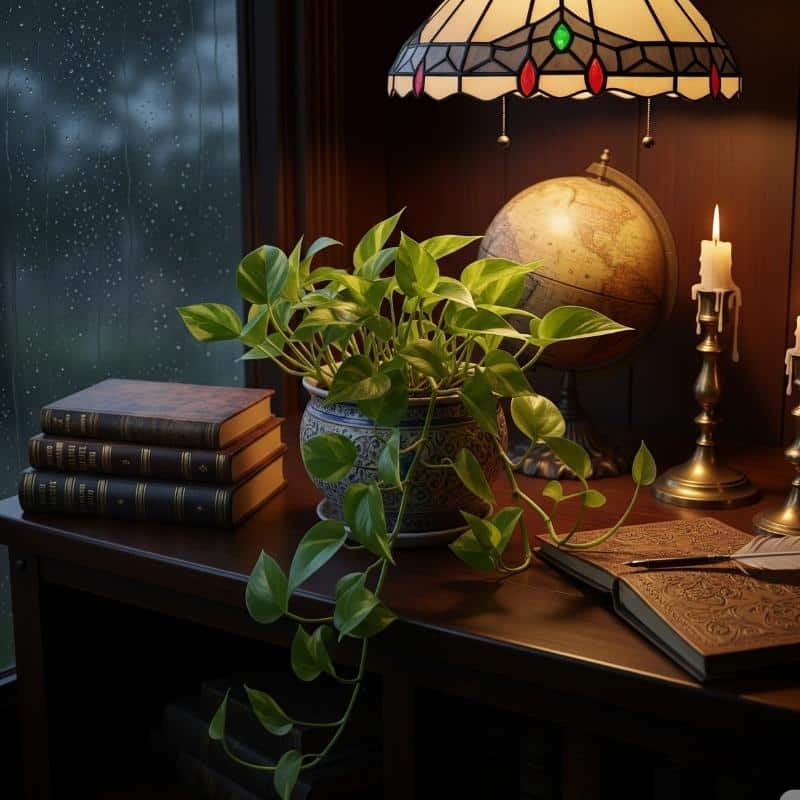
The Pothos is a humble but essential plant. Its heart-shaped leaves and incredibly forgiving nature make it a reliable companion that thrives even when you’re lost in a book for weeks on end.
The Dark Academia Connection: A scholar’s life is often one of intense focus, which can lead to neglect of worldly things. Because the Pothos is so resilient and tolerant of low light and inconsistent watering, it can survive and even thrive in the often-dim and sometimes-forgotten corners of a study. As a result, it represents a steadfast, low-maintenance companionship, always there when you look up from your work.
- Aesthetic Contribution: Adds a touch of lush life to high shelves and dark corners. The ‘Marble Queen’ variety has a beautiful, parchment-like variegation.
- Styling & Materials: Perfect for placing on top of a tall bookshelf, allowing its vines to cascade down the sides.
- The Scholarly Factor: Its resilience is a quiet lesson in perseverance—a valuable trait for any academic pursuit.
Philodendron hederaceum (Heartleaf Philodendron) – The Velvet Shadow
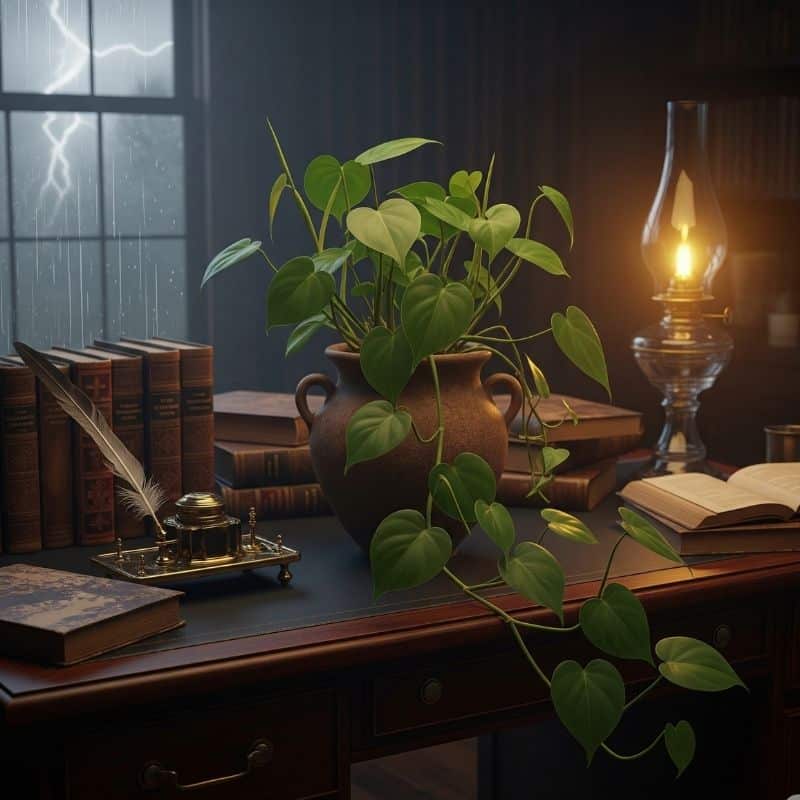
Similar to the Pothos but with distinctly velvety, heart-shaped leaves, this philodendron offers a softer, more romantic texture. Its deep green color and trailing habit are perfect for creating a sense of moody enclosure.
The Dark Academia Connection: The aesthetic often plays with light and shadow. Because the Heartleaf Philodendron has a deep, non-reflective, velvety texture, it seems to absorb light rather than reflect it. This makes it perfect for creating pockets of deep, contemplative shadow and adding to a room’s sense of mystery and intimacy.
- Aesthetic Contribution: A soft, velvety texture and a classic, romantic heart shape.
- Styling & Materials: Let it trail from a dark wooden mantelpiece or a hanging brass planter.
- The Scholarly Factor: Its name, Philodendron, comes from the Greek “philo” (love) and “dendron” (tree), a fittingly classical name for a scholar’s home.
Prayer Plant (Maranta leuconeura) – The Living Manuscript
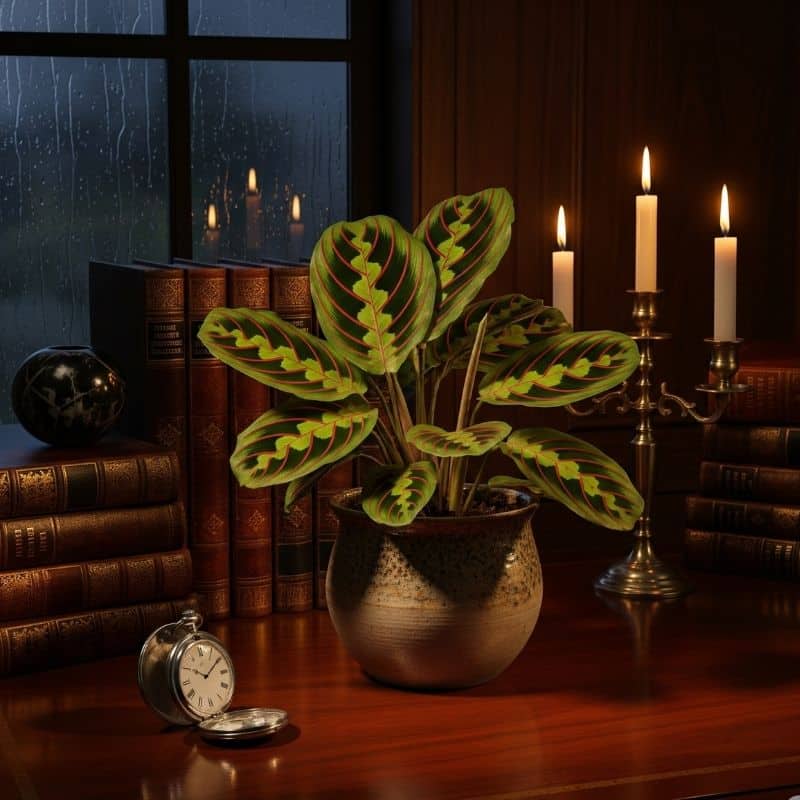
The Prayer Plant is a work of art. Its leaves are adorned with intricate patterns and deep red veins, resembling something from an illuminated manuscript or an ancient botanical drawing.
The Dark Academia Connection: An essential aspect of the aesthetic is valuing objects that are beautiful, detailed, and rich in meaning. Because the Prayer Plant’s leaves are so detailed and artistic, they invite close observation and study, much like a historical text or a detailed map. Moreover, its habit of folding leaves upward at night, as if in prayer or contemplation, introduces a ritualistic, thoughtful touch to the day’s end.
- Aesthetic Contribution: Intricate, colorful patterns that provide a point of detailed visual interest.
- Styling & Materials: Best in a simple, low bowl where its leaves can be the main feature. A dark, moody ceramic enhances its colors.
- The Scholarly Factor: Its nightly movement (nyctinasty) is a fascinating biological process, a perfect subject for observation and journaling.
Alocasia ‘Black Velvet’ – The Alchemist’s Jewel
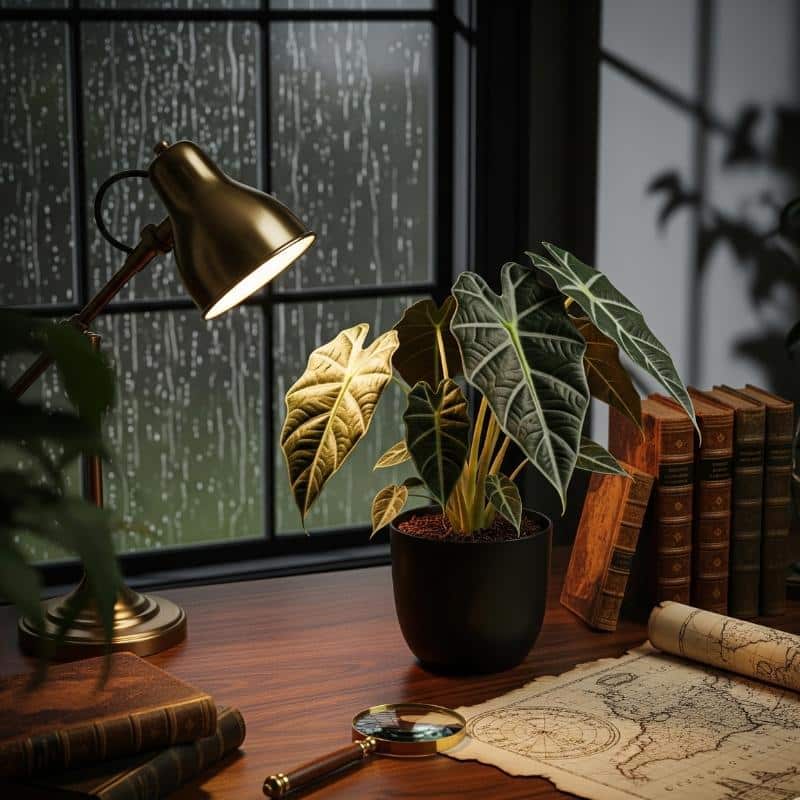
This is a plant of pure drama and texture. The leaves exhibit a rich, velvety black-green hue, sharply contrasted by vivid, silvery veins. It feels rare and precious, like an exotic ingredient in an alchemist’s laboratory.
The Dark Academia Connection: Dark Academia loves mystery, esoterica, and the allure of hidden knowledge. Because the ‘Black Velvet’ looks so otherworldly and precious, it evokes a sense of alchemy and forgotten lore. Therefore, it’s not just a plant; it’s a conversation piece that hints at strange and wonderful secrets.
- Aesthetic Contribution: A stunning combination of velvety black texture and electric silver lines.
- Styling & Materials: It deserves a special pot. A small, footed planter or a vintage silver goblet would complement its jewel-like quality.
- The Scholarly Factor: Due to its specific care needs, such as high humidity and careful watering, it becomes a “specimen” to study. Thus, it appeals to a detail-oriented, scientific mind.
Rex Begonia – The Stained Glass
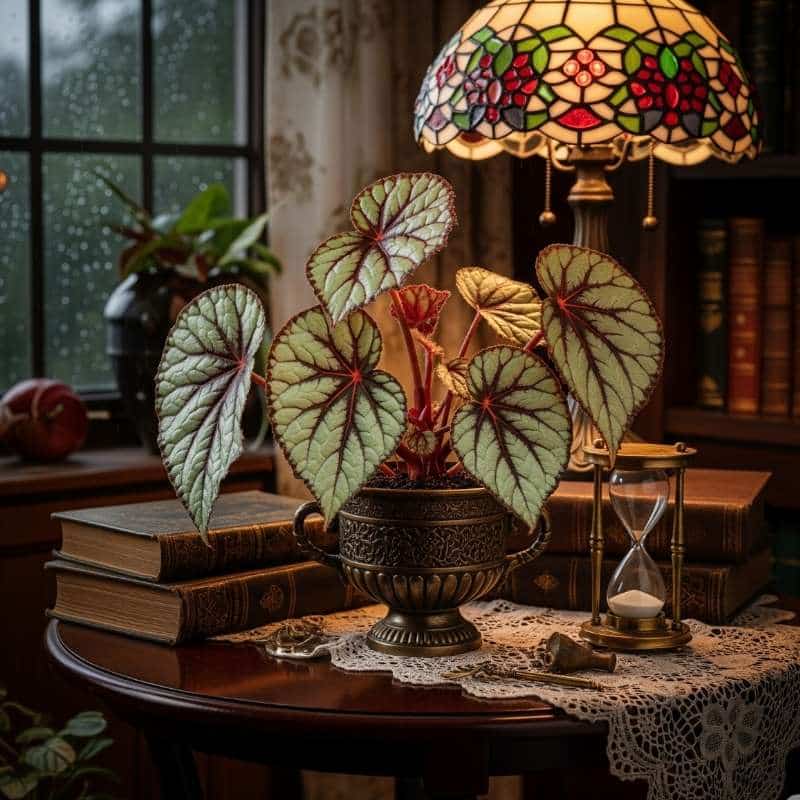
Rexes are known for their spectacular, asymmetrical leaves, which come in a dizzying array of dark, moody colors—deep reds, purples, silvers, and near-blacks—often in swirling, dramatic patterns.
The Dark Academia Connection: The aesthetic draws heavily on Gothic architecture and art. Because the leaves of a Rex Begonia feature rich colors and intricate, luminous patterns, they resemble stained-glass windows. Similarly, they are reminiscent of those found in an old cathedral or library. As a result, they bring a touch of Gothic splendor and artistic complexity to a room.
- Aesthetic Contribution: An explosion of dark, rich color and pattern.
- Styling & Materials: Place it where light can filter through its leaves, making them glow. A simple, dark pot is best.
- The Scholarly Factor: Due to their sheer variety, Rex Begonias have become a collector’s item. Thus, they appeal to the completist and curatorial nature of a scholar.
Specimens of Curious Form
Maidenhair Fern (Adiantum) – The Delicate Poet

The Maidenhair Fern is one of the most delicate and graceful plants. Delicate black stems support tiny, fan-shaped leaves that appear to hover in the air, quivering at the faintest breeze.
The Dark Academia Connection: This aesthetic values sensitivity, poetry, and a touch of tragic beauty. Since the Maidenhair Fern is famously delicate, it demands specific conditions like high humidity and consistent moisture. Therefore, it symbolizes a fragile yet poetic beauty. Caring for it is an act of devotion, much like memorizing a difficult poem or mastering a classical instrument.
- Aesthetic Contribution: Adds a layer of extremely fine, airy, and light texture.
- Styling & Materials: It is stunning when displayed in a Victorian-style glass cloche or placed in a self-watering pot within a dim, humid corner.
- The Scholarly Factor: Its fragility is a memento mori—a quiet reminder of the transient nature of beauty, a common theme in classic literature.
Venus Flytrap (Dionaea muscipula) – The Curious Specimen
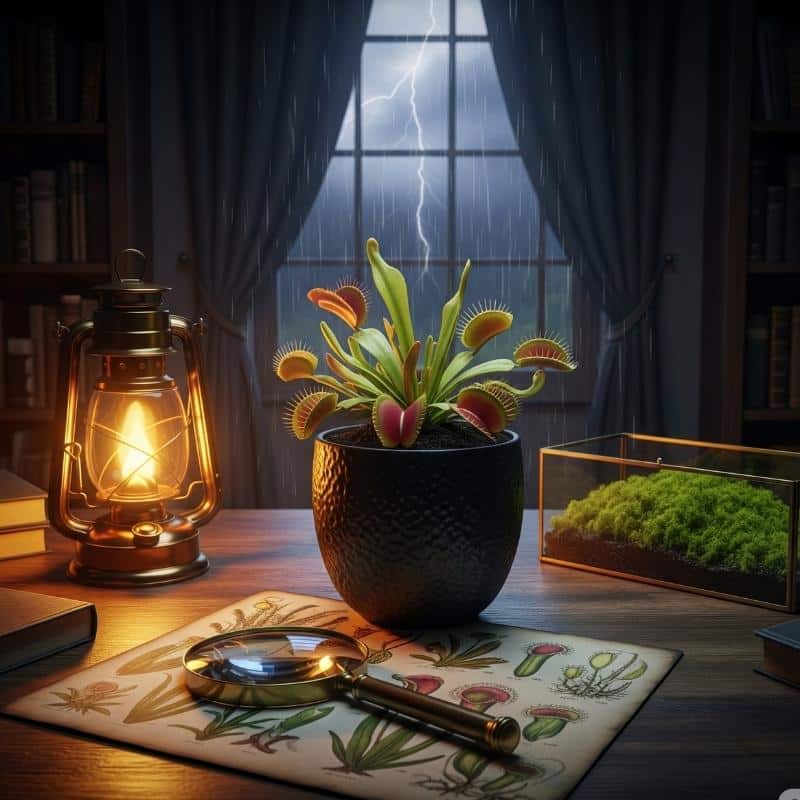
This carnivorous plant is less of a decoration and more of a living scientific wonder. Its jaw-like traps are a marvel of evolution, a subject of endless fascination.
The Academia Connection: The pursuit of knowledge often involves a fascination with the strange, the unusual, and the workings of the natural world. Because the Venus Flytrap is an active, carnivorous organism that defies the typical definition of a plant, it is the ultimate conversation piece for a biologist, a philosopher, or anyone interested in the oddities of nature. Therefore, it’s a living display of natural science.
- Aesthetic Contribution: A strange and fascinating sculptural form.
- Styling & Materials: Best kept in its simple plastic pot, sitting in a tray of distilled water on a bright windowsill, like a specimen in a lab.
- The Scholarly Factor: Its feeding mechanism and unique habitat are a direct link to the studies of Charles Darwin and the world of natural history.
Peace Lily (Spathiphyllum) – The Dramatic Contrast
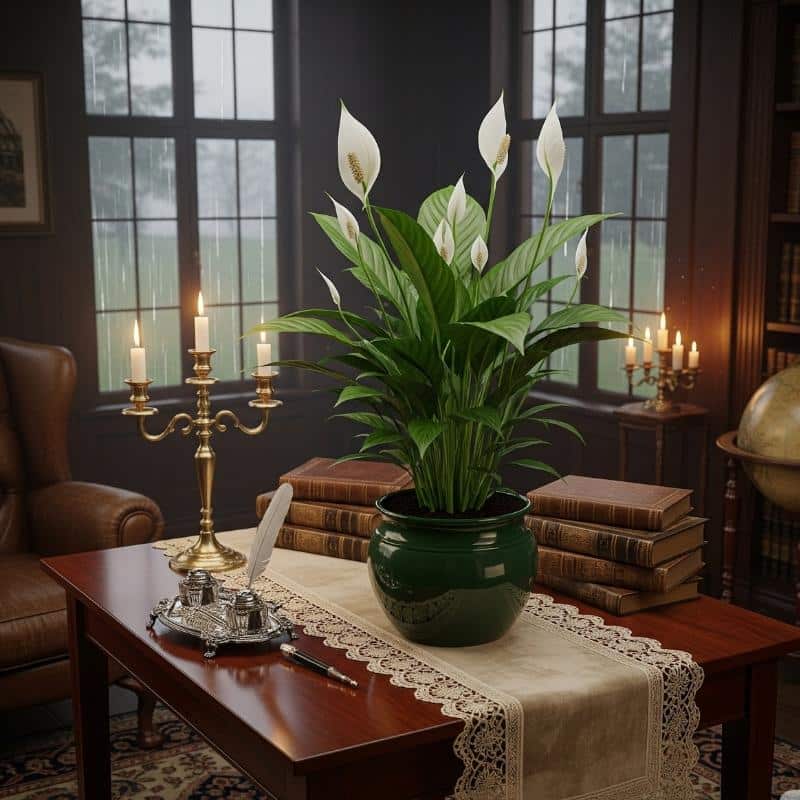
Often found in brighter spaces, the Peace Lily’s dramatic form gains deeper significance in a Dark Academia setting. The glossy, deep green leaves paired with striking white, sculptural flowers form a bold and captivating contrast.
The Dark Academia Connection: The aesthetic often uses chiaroscuro—the strong contrast between light and dark. Because the Peace Lily’s single white bloom emerges from a mass of dark foliage, it is a perfect example of a single point of light in the darkness. This creates a dramatic, almost theatrical effect, like a single candle in a dark room.
- Aesthetic Contribution: A striking contrast of black-green and pure white.
- Styling & Materials: In a simple, dark planter, its white flower becomes even more luminous.
- The Scholarly Factor: Its common name hints at tranquility, providing a sense of calm focus needed for deep study.
Hoya – The Ancient Relic
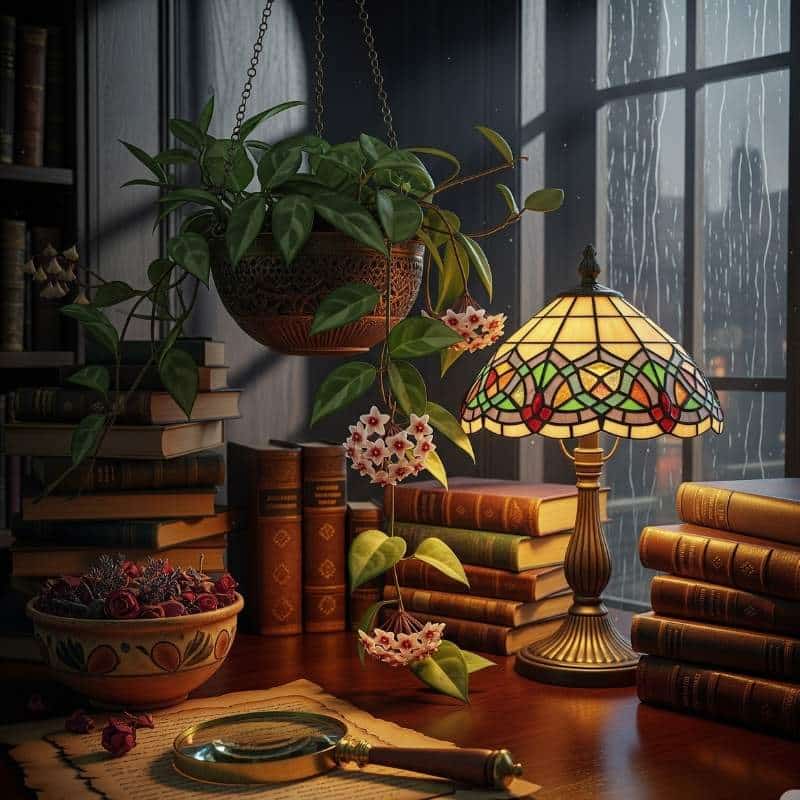
Hoyas, or Wax Plants, have a timeless quality. Their thick, waxy leaves resemble carved artifacts. The star-shaped flower clusters (umbels) appear as delicate porcelain jewelry.
The Dark Academia Connection: This aesthetic appreciates objects with a sense of history and permanence. Hoya leaves, being sturdy and durable, and their geometric flowers, resemble ancient relics. They feel less like fleeting blooms and more like timeless treasures. As a result, they add a sense of age and wonder to a space.
- Aesthetic Contribution: Waxy, often dark green leaves and stunning, intricate flowers.
- Styling & Materials: Let a trailing variety like Hoya carnosa hang from a high shelf, its waxy ropes of leaves weaving between old books.
- The Scholarly Factor: The incredible diversity of the Hoya genus makes it a prime candidate for a collector, appealing to the systematic and cataloging mind of a scholar.
String of Spades/Hearts (Ceropegia woodii) – The Tangled Romance
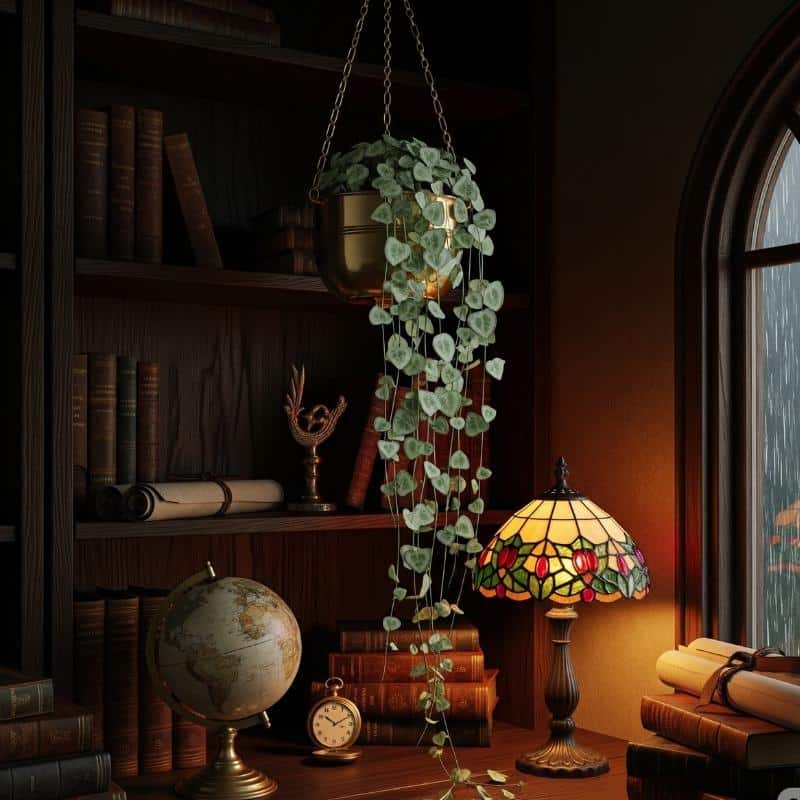
The String of Hearts, with its heart-shaped leaves, exudes a romantic and melancholic vibe. In a Dark Academia setting, it resembles a pressed flower in a forgotten love letter. The ‘String of Spades’ variety, characterized by its darker and more pointed leaves, enhances this aesthetic even further.
The Dark Academia Connection: Literature and history are filled with tales of romance, longing, and tragedy. Because these delicate vines create tangled, intricate lines, they can represent the complex, intertwined narratives of a classic novel. They provide a soft, organic counterpoint to the rigid structure of books and shelves.
- Aesthetic Contribution: Adds delicate, intricate, and romantic trailing lines.
- Styling & Materials: Hang them over a framed painting, a mirror, or let them cascade from a small, dark terracotta pot placed on a mantelpiece.
- The Scholarly Factor: Their delicate nature requires a gentle hand and careful observation, much like the close reading of a text.
Asparagus Fern (Asparagus setaceus) – The Whispering Foliage
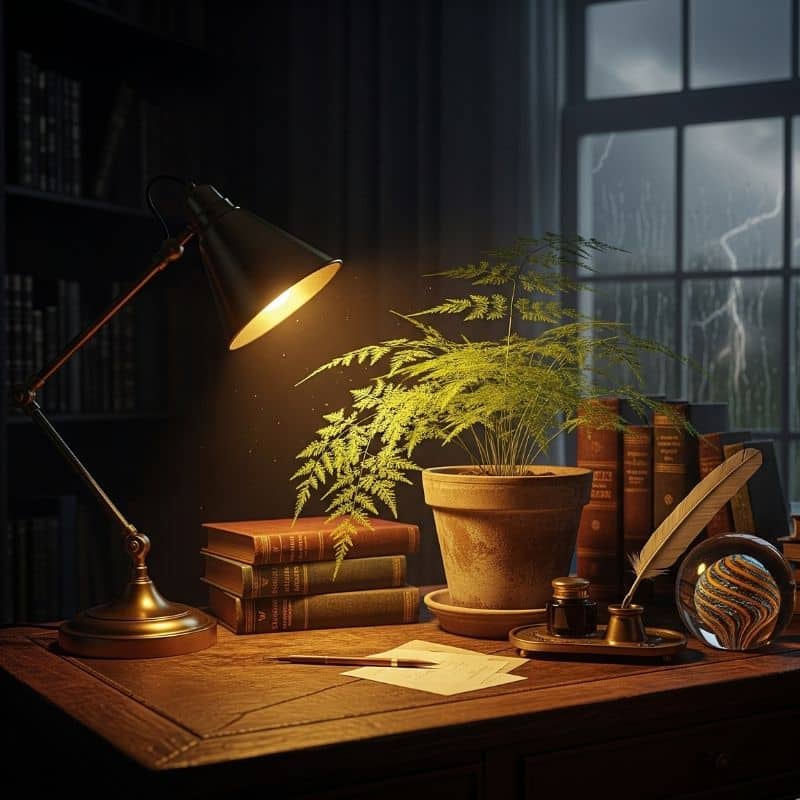
The Asparagus Fern’s fine, cloud-like foliage is perfect for adding a layer of soft, complex texture. It can fill a space with greenery without making it feel heavy or blocked.
The Dark Academia Connection: Imagine a quiet, dusty library where the only sound is the turning of pages. Because the foliage of this plant is so fine and airy, it seems to capture light and shadow in a soft, whispering way. This contributes to the quiet, contemplative, and slightly mysterious atmosphere that is essential to the aesthetic.
- Aesthetic Contribution: A unique, almost ethereal texture that softens hard edges.
- Styling & Materials: Looks wonderful in an old, weathered clay pot or a vintage-style planter.
- The Scholarly Factor: Its intricate, fractal-like branching serves as a stunning representation of natural geometry.
Calathea – The Ornate Tapestry
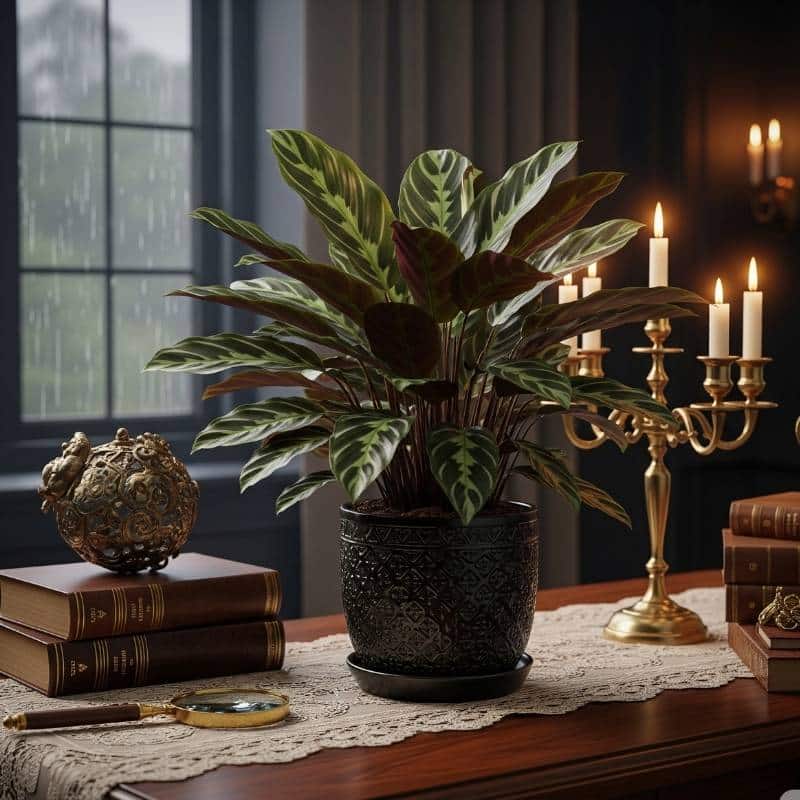
Calatheas are famous for their ornate, patterned leaves. Varieties like the Medallion or Ornata feature intricate pinstripe patterns. These designs resemble brushstrokes or a woven tapestry.
The Dark Academia Connection: This aesthetic honors the value of craftsmanship and artistry. Because Calathea leaves are so incredibly detailed and decorative, they are like having a living piece of William Morris wallpaper. They evoke a sense of history and artistry. Their luxurious details complement velvet, dark wood, and leather textures.
- Aesthetic Contribution: It adds intricate, artistic patterns. Often, the undersides of the leaves bring a touch of deep purple or red.
- Styling & Materials: Best as a tabletop plant where its intricate details can be admired. A simple, dark ceramic bowl is a perfect choice.
- The Scholarly Factor: The nyctinasty, or daily leaf movement, gently reminds us of nature’s rhythms. It reflects the continuous flow of time.
Curating Your Scholarly Sanctuary
Choosing plants for a Dark Academia home is like curating a personal museum or library. Each plant should have a story, a purpose, or a form that sparks curiosity and encourages contemplation. It’s about creating an atmosphere steeped in history, knowledge, and the poetic beauty of the natural world.
If you liked this article, you might also like our article on “The Bohemian Plants: 20 Plants to Perfect Your Boho-Chic Decor.“

